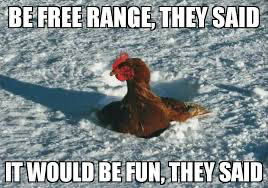When you think of free-range eggs, what do you think of? Chickens on green grassy pastures? Eating bugs and grubs and running around the backyard?
When it comes to egg production, people have a lot of questions with regards to labels and what they all mean. Free range? Vegetarian fed? Organic? And why do some fetch a higher price point? Is it worth it to pay two to three times more for these labels?
The short answer is: It depends on where you get them. If you know your farmer, the answer could very well be yes. If you’re buying eggs in the grocery store that come from larger-scale farms, the answer is most likely no.
Over 90 percent of eggs in the U.S. come from larger-scale farms, where the hens are raised in cages. Why? Chickens are prone to disease, predators, feather plucking from other birds, weather elements, etc. The image of backyard chickens is nice, until this happens:

When larger food corporations sell the “free-range” or “cage-free” eggs, it most likely doesn’t mean what you may think. Cage free is a popular marketing label, but really all that means is that they’re still raised in barns, except they can run around within it. The problem here, however, is that they’re more prone to feather plucking and bullying from other hens, and they’re more susceptible to injury. Cage free still has different levels within the barns, so they can jump and (attempt to) fly about a little. This means they can crush each other a bit or maybe not quite make it to their clumsy flight destination. Not only this, but the barns aren’t always as clean, and chickens don’t always lay eggs where they are supposed to. They can be a bit more dusty and not as good for farm workers, and eggs most likely aren’t as clean, or the yields aren’t as strong.
So this is the whole reason caged systems were invented! To mitigate these problems. However, it “sounds” good to the average consumer or animal-rights activists. It’s important to talk to the real large-scale egg farmers and experts within the industry to learn the truth and understand the reason why things are done the way they are. Eggs are produced efficiently and safely in the U.S., with contracts and inspections to help ensure reliability.
Let’s take “cage free” a step further with “free range.” Same rules apply as what’s described above except they have “access” to the outdoors. That access is a small hole in the side of the barn that allows them to go outside. But the outside area doesn’t have to be big or grassy at all and they don’t usually choose to use it.
So, a lot of it is marketing gimmick buzzwords. For me personally, I always buy the cheapest eggs in the grocery store but always try to buy local first and foremost. If you know your farmer, you can ask exactly how they’re raised or take a tour!
But make no mistake, chickens that are truly free range and pasture raised are delicious to you and me but are also tasty to predators, like coyotes and eagles. Small-scale backyard chickens are definitely not raised without challenges, so there are pluses and minuses to every system. Overall though, small family farmers in your community are usually the best place to look if you want chickens that are actually raised outdoors and cage free.
Michelle Miller, the Farm Babe, is an Iowa-based farmer, public speaker, and writer, who lives and works with her boyfriend on their farm, which consists of row crops, beef cattle, and sheep. She believes education is key in bridging the gap between farmers and consumers.



